The local area of expansion (flare rate) dictates how low the mid will play. The cross sectional area dictates how high you will get high frequency loading from the horn. This is a different issue than the 1/2 wave length cancellation notch. The area the mid taps into needs to have a circumference less than or equal to the wave length of highest frequency of interest. For 900Hz you want to tap into the horn where the area is approximately 115cm^2 and 146cm^2 for 800Hz. You have to balance the 1/2 wave length cancellation notch, the local area of expansion, and the area of the tap in point all simultaneously to get a Unity or Synergy horn to work correctly.
My Paraline experiments inspired me to try something which is basically equivalent to an unfolded paraline. A Paraline is a horn with a coverage angle of zero degrees that radiates in 360 degrees. If you take a ninety degree slice out of that, you end up with this:
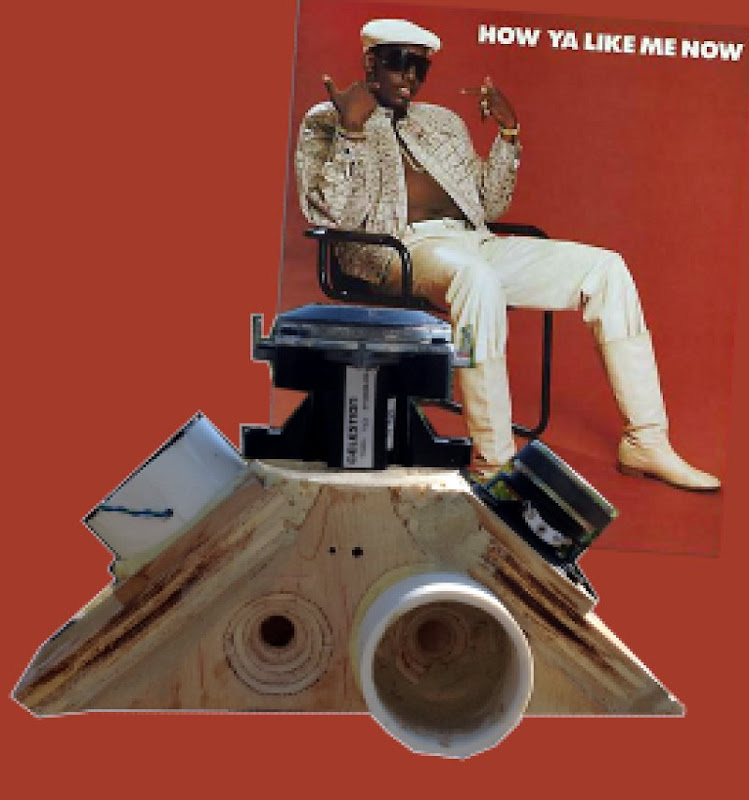
Details here:DIYMA Car Audio Forum - View Single Post - Creating The Perfect Soundstage

Details here:DIYMA Car Audio Forum - View Single Post - Creating The Perfect Soundstage
I ordered some of the Visaton M10 drivers and just measured the specs-
FS=629
VAS=0.2ltr
QTS=3.24
QES=5.19
QMS=8.58
I measured 2 of the drivers and obtained similar results with both. The VAS was measured with the added mass method. If anyone is interested I got my drivers through this company- M 10 - 8 Ohm
I am going to have a go at designing a Synergy horn now I have these specs.
Cheers Paul
FS=629
VAS=0.2ltr
QTS=3.24
QES=5.19
QMS=8.58
I measured 2 of the drivers and obtained similar results with both. The VAS was measured with the added mass method. If anyone is interested I got my drivers through this company- M 10 - 8 Ohm
I am going to have a go at designing a Synergy horn now I have these specs.
Cheers Paul
I know there's a lot of people reading this thread that don't have the time to build a synergy horn, or the space that's required to get it to play down to 300hz. Here's an alternative you might consider:
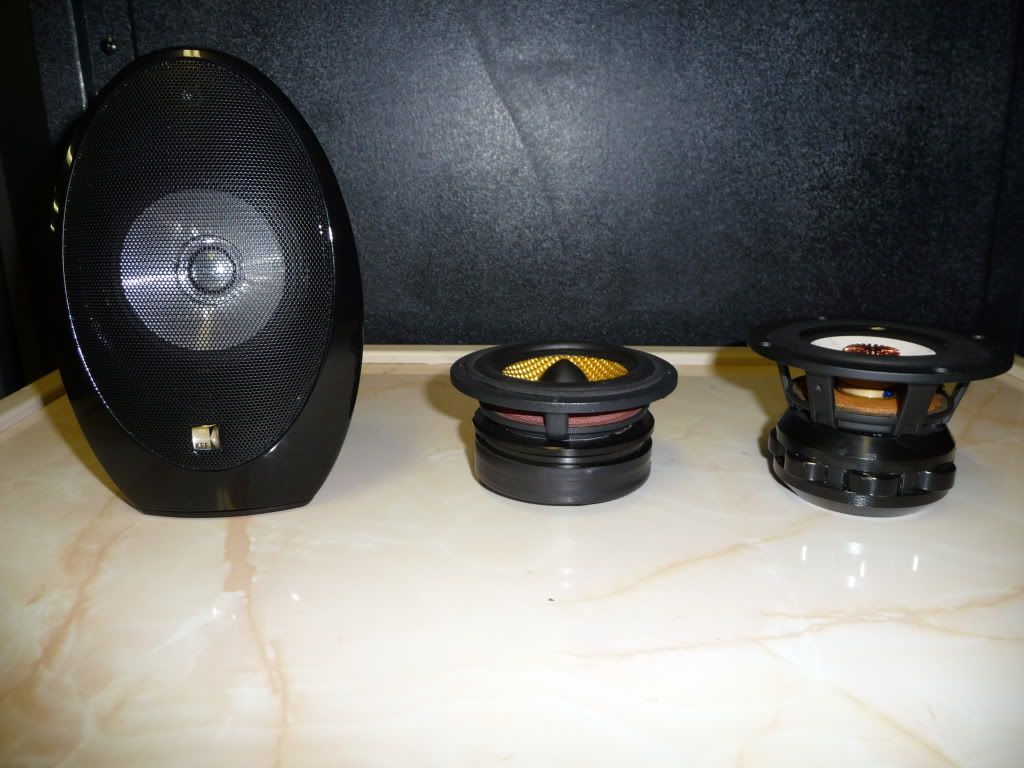
This is the satellite from a KEF KHT1005. Here's a list of reasons you might consider it in lieu of a Synergy horn:
1) after screwing around with Unity horns for over half a decade, I'm convinced that their fundamental goodness has little to do with their efficiency, and a LOT to do with the near-perfect transition from midrange to tweeter. Basically a Unity/Synergy horn fools our brain into thinking it's one wide-bandwidth driver.
2) Once you hear this done properly, conventional two-ways will never sound the same; I can't listen to a conventional two-way without *immediately* knowing that something is wrong. Literally the second I walk into a room.
3) The KEF UNI-Q isn't perfect, but it has a LOT of the Unity goodness. I think this is due to (you guessed it) the near-perfect transition from midrange to tweeter. This is especially notable on vocals and percussion.
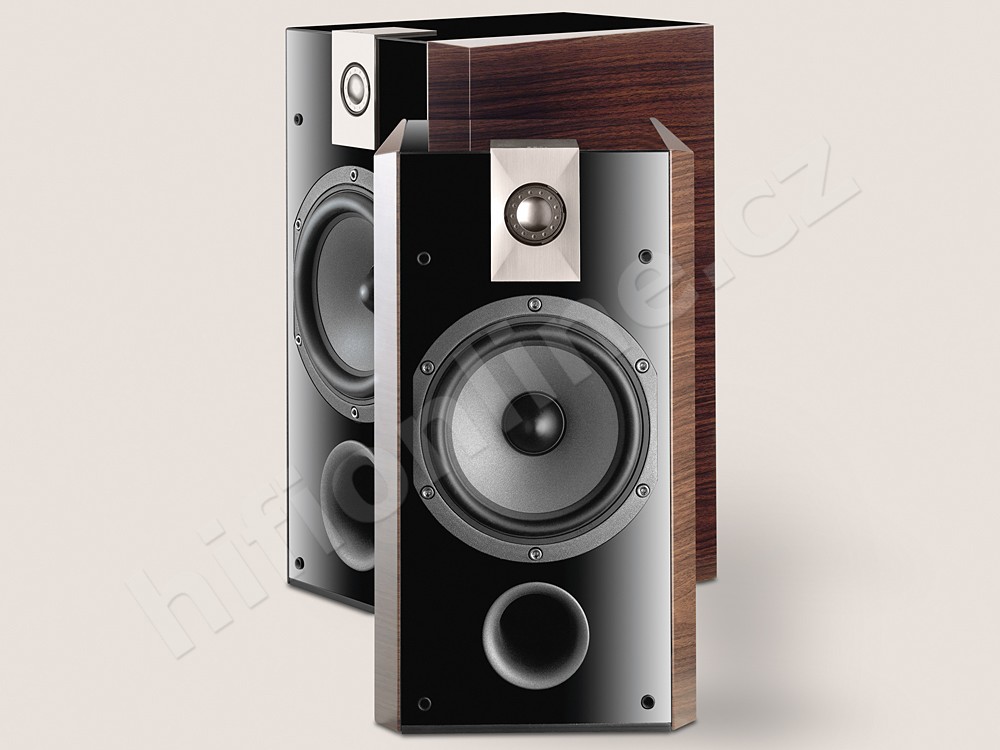
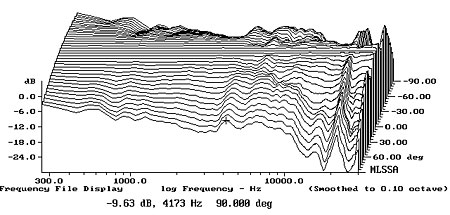
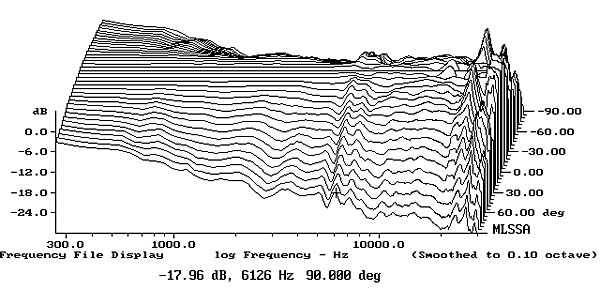
4) One way to determine if a loudspeaker has some of that Unity goodness is to look at the polar response. The graph above shows the polar response of two loudspeakers. The first is a conventional two-way (Focal Chorus 807V) and the second is a Kef UNI-Q (Q900).
Note how the transition from the Kef's midrange to tweeter is nearly perfect? To the microphone, it seems to be one driver. There's a little 'wiggle' at 5khz where the midrange hands off to the tweeter. But that 'wiggle' isn't as severe as the noticeable widening of directivity that occurs with the Focal two-way. (Note how the Focal directivity gets much broader at 4khz? That's because the tweeter is much smaller than the woofer, and so has wider directivity. In the Kef, the midrange cone acts like a waveguide for the tweeter, so the directivity change is verrrrrrrry slooooooow.
I couldn't find any directivity plots of the KHT1005 online, but I'm willing to bet it's comparable to the Q900 that was measured by Stereophile.
Here's a frequency response measurement of the KHT1005 satellite, from Home Theater magazine.
Last but not least, I think that one of the most important reasons that Synergy horns don't sound like regular speakers is that they're symmetrical. For instance, a regular two-way speaker is generally optimized for good horizontal directivity (if it's optimized at all.) It's hard to get good vertical directivity from a two-way, due to the fact that the pathlength differences vary greatly depending on angle. The Synergy horns don't have this problem; if you flip an SH-50 on it's side, the directivity is the same.
The same is true with a Kef UNI-Q, at least down to 300hz or so. (Synergy SH-50 is admittedly symmetrical down to a much lower frequency.)
If all of this has piqued your curiosity, the final icing on the cake is that the UNI-Q can be had for about $50 per satellite for the next 24 hours. Newegg has them on their Black Friday flyer. Even if you DIY, it's pretty easy to spend $50 per channel on a Synergy horn *crossover*, and that doesn't even factor in the cost of drivers, labor, failed experiments, and anti-depressants when your midranges don't work
I'm putting my money where my mouth is, and buying ten
http://www.newegg.com/Product/Produ...212-Index-_-HomeAudioSpeakers-_-82156028-L06A
promo code is EMCJJHF34 and it's good for 24 hours.
Happy Thanksgiving!
An externally hosted image should be here but it was not working when we last tested it.

This is the satellite from a KEF KHT1005. Here's a list of reasons you might consider it in lieu of a Synergy horn:
1) after screwing around with Unity horns for over half a decade, I'm convinced that their fundamental goodness has little to do with their efficiency, and a LOT to do with the near-perfect transition from midrange to tweeter. Basically a Unity/Synergy horn fools our brain into thinking it's one wide-bandwidth driver.
2) Once you hear this done properly, conventional two-ways will never sound the same; I can't listen to a conventional two-way without *immediately* knowing that something is wrong. Literally the second I walk into a room.
3) The KEF UNI-Q isn't perfect, but it has a LOT of the Unity goodness. I think this is due to (you guessed it) the near-perfect transition from midrange to tweeter. This is especially notable on vocals and percussion.


An externally hosted image should be here but it was not working when we last tested it.

4) One way to determine if a loudspeaker has some of that Unity goodness is to look at the polar response. The graph above shows the polar response of two loudspeakers. The first is a conventional two-way (Focal Chorus 807V) and the second is a Kef UNI-Q (Q900).
Note how the transition from the Kef's midrange to tweeter is nearly perfect? To the microphone, it seems to be one driver. There's a little 'wiggle' at 5khz where the midrange hands off to the tweeter. But that 'wiggle' isn't as severe as the noticeable widening of directivity that occurs with the Focal two-way. (Note how the Focal directivity gets much broader at 4khz? That's because the tweeter is much smaller than the woofer, and so has wider directivity. In the Kef, the midrange cone acts like a waveguide for the tweeter, so the directivity change is verrrrrrrry slooooooow.
I couldn't find any directivity plots of the KHT1005 online, but I'm willing to bet it's comparable to the Q900 that was measured by Stereophile.
An externally hosted image should be here but it was not working when we last tested it.
Here's a frequency response measurement of the KHT1005 satellite, from Home Theater magazine.
Last but not least, I think that one of the most important reasons that Synergy horns don't sound like regular speakers is that they're symmetrical. For instance, a regular two-way speaker is generally optimized for good horizontal directivity (if it's optimized at all.) It's hard to get good vertical directivity from a two-way, due to the fact that the pathlength differences vary greatly depending on angle. The Synergy horns don't have this problem; if you flip an SH-50 on it's side, the directivity is the same.
The same is true with a Kef UNI-Q, at least down to 300hz or so. (Synergy SH-50 is admittedly symmetrical down to a much lower frequency.)
If all of this has piqued your curiosity, the final icing on the cake is that the UNI-Q can be had for about $50 per satellite for the next 24 hours. Newegg has them on their Black Friday flyer. Even if you DIY, it's pretty easy to spend $50 per channel on a Synergy horn *crossover*, and that doesn't even factor in the cost of drivers, labor, failed experiments, and anti-depressants when your midranges don't work
I'm putting my money where my mouth is, and buying ten
http://www.newegg.com/Product/Produ...212-Index-_-HomeAudioSpeakers-_-82156028-L06A
promo code is EMCJJHF34 and it's good for 24 hours.
Happy Thanksgiving!
I know there's a lot of people reading this thread that don't have the time to build a synergy horn, or the space that's required to get it to play down to 300hz. Here's an alternative you might consider:
An externally hosted image should be here but it was not working when we last tested it.

This is the satellite from a KEF KHT1005. Here's a list of reasons you might consider it in lieu of a Synergy horn:
1) after screwing around with Unity horns for over half a decade, I'm convinced that their fundamental goodness has little to do with their efficiency, and a LOT to do with the near-perfect transition from midrange to tweeter. Basically a Unity/Synergy horn fools our brain into thinking it's one wide-bandwidth driver.
2) Once you hear this done properly, conventional two-ways will never sound the same; I can't listen to a conventional two-way without *immediately* knowing that something is wrong. Literally the second I walk into a room.
3) The KEF UNI-Q isn't perfect, but it has a LOT of the Unity goodness. I think this is due to (you guessed it) the near-perfect transition from midrange to tweeter. This is especially notable on vocals and percussion.
FWIW, I've had a quad of those baby KEF eggs for quite some time. Three of them are going to end up in my Citroën at some point. (One spare.) They're fairly smooth-sounding, though they get nasal if pushed.
For those who can fit it, KEF's slightly larger 3005 egg is a lot better. The midrange is cleaner, and the treble is a lot better due to the radial phase plug and possibly just better tweeter design. The raw driver isn't that expensive to buy from Speaker exchange, either.
The new Q100 driver is better still, but much larger. (Bigger diameter, and MUCH bigger motor structure because it's ferrite rather than neo.)
And I agree, midrange mushroom cloud polar response (as found on that Focal) is very obvious, and very annoying.
John (Patrick John, not John-John), Tried to send you a pm, your box is full.
fixed!
Ha, its full again.
Anyway, these specs sound ok?
Fs 74hz
Spl 95db
Qes. 25
Accordian surround
yes, very good. What is it?
Over on the hornresp thread, a forum member from Amsterdam noted that you can import data from Hornresp into FRD tools.
This is very very helpful, especially if you don't want to hassle with Akabak. And even if you *do* know Akabak, I think that the FRD tools are faster to use, because it's time consuming to create a complex model in Akabak.
Here's some things you could do with this:
1) You can model the offset midranges in a Unity/Synergy horn, and include a high pass
2) You can do funky variations of a synergy horn, like a Synergy horn with a 'peaky' vent and a highpass to tame that peak. (As JLH noted about a year back in this thread, the Danley SH50 uses a vented box for the woofers with an unconventional alignment.)
3) You can model tapped horns with a highpass to lower excursion and a low pass to filter out the top end
very very cool
 [/img]
[/img]
Here's a screen cap of a Paraline modeled in hornresp and export to Bagby's passive xover designer
instructions are in the hornresp thread
This is very very helpful, especially if you don't want to hassle with Akabak. And even if you *do* know Akabak, I think that the FRD tools are faster to use, because it's time consuming to create a complex model in Akabak.
Here's some things you could do with this:
1) You can model the offset midranges in a Unity/Synergy horn, and include a high pass
2) You can do funky variations of a synergy horn, like a Synergy horn with a 'peaky' vent and a highpass to tame that peak. (As JLH noted about a year back in this thread, the Danley SH50 uses a vented box for the woofers with an unconventional alignment.)
3) You can model tapped horns with a highpass to lower excursion and a low pass to filter out the top end
very very cool

Here's a screen cap of a Paraline modeled in hornresp and export to Bagby's passive xover designer
instructions are in the hornresp thread
Does it pull over the correct phase too? Or is that extracted from the impedence file?
The phase of the loudspeaker amplitude is in the FRD file, and the phase of the loudspeaker impedance is in the ZMA file.
When i get a chance I'll have to sim some of my existing designs using this, as I typically just used a first order xover and adjusted the components until the output was reasonably flat. If you check out some of videos on youtube, you'll notice that the frequency response is kinda rough, due to my crude xovers. (I *hate* working on xovers; it's a lot more fun to build loudspeakers than xovers.)
You can copy everything with SPLtrace, covert the data and use it in lspcad pro...that's how I did the passives for my old micro unities. But I do like Jeff's program a little bit better. I never (or don't remember) modeled my unity in PCD.
Oh, I remember why I didn't use PCD...the SPL divisions weren't fine enough when you put it over to the highest SPL settings. But in hindsight, I could have relabeled the divisions in SPLtrace a different value to bring them down to a "normal" range.
I loved the challenge of doing the passives. And I re-read the Unity stuff again and found more info that I missed the first time that would have probably gotten even better results. Big shout out the JLH for the pointers. I am debating on doing passives or active for the next setup...really need in car measurements to do it right.
Still not sure which way to go...been posting little on your site.
Oh, I remember why I didn't use PCD...the SPL divisions weren't fine enough when you put it over to the highest SPL settings. But in hindsight, I could have relabeled the divisions in SPLtrace a different value to bring them down to a "normal" range.
I loved the challenge of doing the passives. And I re-read the Unity stuff again and found more info that I missed the first time that would have probably gotten even better results. Big shout out the JLH for the pointers. I am debating on doing passives or active for the next setup...really need in car measurements to do it right.
Still not sure which way to go...been posting little on your site.
I know there's a lot of people reading this thread that don't have the time to build a synergy horn, or the space that's required to get it to play down to 300hz. Here's an alternative you might consider:<snip>
If anyone is interested in the Kefs, here are some updates on them:
1) Newegg has them on sale again, for the next 96 hours. For $249 you get a powered 8" sub and five 3" coaxial satellites. A screaming deal, considering that the Seas H1602 is $160 each.
2) I measured mine. Here are the parameters:
fs = 149.4hz
qms = 1.083
qes = 0.6459
qts = 0.40
bl = 2.2
sensitivity = 87dB
le = 0.34
sd = 25cm^2
I didn't measure the VAS; I'd guess it's around one liter, based on the VAS specs of comparable drivers from Peerless and Audience.
One thing that surprised me about the Kef drivers was how fragile they are. The cone is probably the thinnest aluminum I've ever seen. Compared to the Peerless 3", I'd estimate it's cone is about half the weight. This has some 'neat' advantages for DIY, because it makes it a good match for a horn. I'm guessing Kef used a very light cone to get sensitivity up, since the very small size of the cone will lead to low efficiency. I simmed the sensitivity using Hornresp, so it may be off by a dB or two. But 87dB is still pretty good for a 2.5" driver.
Here's a couple ideas for the Kef drivers:
1) Stick them in a back loaded horn. Planet10 has some neat designs, and I think the Kef is nearly a drop in for many of the Fostex drivers. The Kef has the advantage of having a seperate midrange and tweeter. Or that could be a disadvantage, depending on how you look at it.

2) If you're *really* brave, I think you could do a low-efficiency clone of the Danley. If you tinker around in hornresp you'll find that you can get the efficiency of the Kef into the 90s if you horn load the midrange and add a coupling chamber. On the downside, the tweeter will limit your SPL. Might just be better to go with a back loaded horn!
Note that the price of $249 includes five passive xovers too, which saves a ton of trial and error.
It seems to me that getting used to lower volumes is really one of the best approaches, since physics is so much more on your side. I'd like to really lower the noise floor at my place so that I can get some threshold shift. Something like 6dB is so much extra energy but so little perceived volume with our hearing mechanism.
Phase coherency really opens up as an option, then. I know it's important to ave enough volume for a realistic experience but 90 dB sounds like 100 dB when it wakes you up at night.
So you get as much satisfaction (or close to it) with those little guys, as with your more powerful speakers?
Phase coherency really opens up as an option, then. I know it's important to ave enough volume for a realistic experience but 90 dB sounds like 100 dB when it wakes you up at night.
So you get as much satisfaction (or close to it) with those little guys, as with your more powerful speakers?
Last edited:
I bought the tiny little Kefs for purely cosmetic reasons.
Basically I used to live in a 2800' house, and when I downsized I had to move my Gedlee Summas into the garage. (There's just no way to fit them in the living room of my new home, and I don't have spare rooms in the new house like I used to have in the old.)
So I bought the Kefs as a 'placeholder', basically something to tide me over until I could get into a home that's better suited for high end audio. (My lease is up in five months )
)
But...
A funny thing happened:
1) I noticed the Kefs image better than anything I've ever owned
2) I noticed the Kefs are really articulate, and work well in small spaces
Both of these things are important to me, particularly item two. I write software for a living, so I spent HOURS in front of a computer monitor every day. So the ability to place a speaker very close to me, and still have it sound good, is a big advantage.
I'm wary to compare the $10,000 Summas to a $600 set of Kefs. Definitely apples and oranges here. In particular since I generally prefer to listen to music with the speakers very close to me. (IE, the Summas were never *designed* to be a nearfield monitor. The Kefs excel in this application because the center-to-center spacing between the tweeter and the woofer is less than three centimeters!)
Basically I used to live in a 2800' house, and when I downsized I had to move my Gedlee Summas into the garage. (There's just no way to fit them in the living room of my new home, and I don't have spare rooms in the new house like I used to have in the old.)
So I bought the Kefs as a 'placeholder', basically something to tide me over until I could get into a home that's better suited for high end audio. (My lease is up in five months
But...
A funny thing happened:
1) I noticed the Kefs image better than anything I've ever owned
2) I noticed the Kefs are really articulate, and work well in small spaces
Both of these things are important to me, particularly item two. I write software for a living, so I spent HOURS in front of a computer monitor every day. So the ability to place a speaker very close to me, and still have it sound good, is a big advantage.
I'm wary to compare the $10,000 Summas to a $600 set of Kefs. Definitely apples and oranges here. In particular since I generally prefer to listen to music with the speakers very close to me. (IE, the Summas were never *designed* to be a nearfield monitor. The Kefs excel in this application because the center-to-center spacing between the tweeter and the woofer is less than three centimeters!)
I understand the downsizing thing completely. I went from a whole house with HT room in Australia to one room here Germany.
My placeholders are 3" units until I can move back (this year hopefully). I have permission to direct funds from my wedding to a horn build. Planning on AMTs at the mouth. I'll try the 3"s as mids. I tend to wonder how big the upgrade will end up sounding...worth it, I hope. I'll make speakers that can get just loud enough for the wedding but are better suited to a house.
I also much prefer nearfield listening, or headphones. Physics is on your side then. We can't change the relative frequencies of sounds but we can scale what's making them and how far away the transducer is.
Do you have the center playing music too, or is it more ambio at the moment?
Btw, hope you have some nice Cherry switches under your fingertips.
My placeholders are 3" units until I can move back (this year hopefully). I have permission to direct funds from my wedding to a horn build. Planning on AMTs at the mouth. I'll try the 3"s as mids. I tend to wonder how big the upgrade will end up sounding...worth it, I hope. I'll make speakers that can get just loud enough for the wedding but are better suited to a house.
I also much prefer nearfield listening, or headphones. Physics is on your side then. We can't change the relative frequencies of sounds but we can scale what's making them and how far away the transducer is.
Do you have the center playing music too, or is it more ambio at the moment?
Btw, hope you have some nice Cherry switches under your fingertips.
- Home
- Loudspeakers
- Multi-Way
- Suitable midrange cone, for bandpass mid in Unity horn.